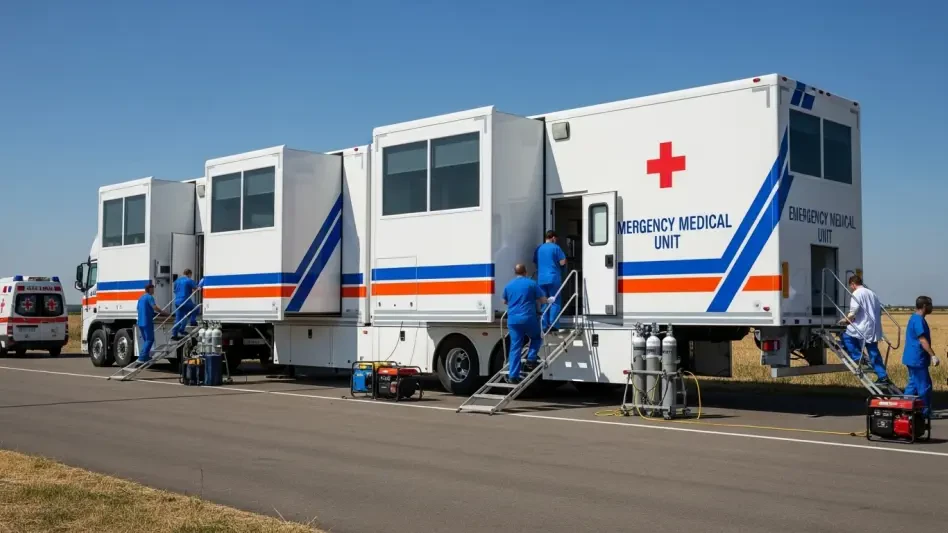Overview of Mobile Clinics in Rural Healthcare
In rural areas across developing economies, millions of people struggle to access basic healthcare due to vast distances and sparse medical infrastructure, creating a dire need for innovative solutions like mobile clinics. Mobile clinics (MCs) have emerged as a critical response to this challenge, delivering essential medical services directly to underserved communities. These portable units, often equipped with basic diagnostic tools and staffed by healthcare professionals, bridge the gap between remote populations and vital care, addressing conditions that would otherwise go untreated.
The significance of mobile clinics lies in their ability to overcome barriers such as long travel times and the absence of local hospitals. By bringing healthcare to the doorstep of rural residents, they ensure timely interventions for chronic diseases like diabetes, hypertension, and heart disease. This approach not only saves lives but also prevents minor health issues from escalating into emergencies, offering a lifeline to those who might otherwise face insurmountable obstacles to treatment.
A key focus of mobile clinics is the consistent management of chronic conditions, which require regular monitoring and early diagnosis to prevent complications. Their presence in remote areas provides continuity of care, ensuring that patients receive follow-up treatments without the burden of traveling to distant facilities. This model of healthcare delivery stands as a beacon of hope for communities often overlooked by traditional systems.
Impact on Health Outcomes and Costs
Boosting Patient Well-Being with Quality-Adjusted Life Years (QALYs)
Research has illuminated the profound effect of mobile clinics on patient health, particularly through metrics like quality-adjusted life years (QALYs). A notable study led by Professor Fang Liu demonstrated that a 12-week visitation schedule for mobile clinics resulted in a staggering 120% increase in healthy life years for patients in rural settings. This improvement stems from the ability of mobile units to provide regular check-ups and early interventions, directly impacting the quality of life for those with chronic illnesses.
The importance of early diagnosis cannot be overstated in remote communities where access to healthcare is limited. Mobile clinics enable the detection of conditions before they progress to severe stages, reducing the risk of complications and hospitalizations. Such proactive care ensures that rural patients receive the attention they need at critical junctures, fundamentally altering health trajectories in these areas.
Beyond immediate outcomes, the long-term benefits of sustained mobile clinic programs are evident in the prevention of disease progression. Regular monitoring helps manage conditions that could otherwise lead to disability or death, offering a sustainable approach to healthcare in regions where permanent facilities are scarce. This consistent presence fosters trust and encourages community engagement with medical services.
Cost Savings in Resource-Limited Environments
In addition to improving health, mobile clinics offer significant economic advantages by reducing healthcare costs in resource-constrained settings. Data indicates that these programs achieve approximately a 5% cost reduction compared to traditional hospital-based care, a crucial saving in areas where budgets are tight. This efficiency arises from minimizing the need for expensive emergency treatments and long-distance travel for medical attention.
The cost-effectiveness of mobile clinics becomes even more pronounced in specific scenarios, such as when hospital expenses are prohibitively high or when diseases progress rapidly without intervention. In such cases, the ability to provide care on-site prevents the financial burden of advanced treatments, benefiting both patients and healthcare systems. This model proves particularly impactful in regions with limited funding for health initiatives.
Moreover, the adaptability of mobile clinics allows for targeted resource allocation, ensuring that funds are used where they are most needed. By focusing on preventive care and routine management, these units help avoid the higher costs associated with acute care in distant facilities. This strategic approach underscores the fiscal prudence of investing in mobile healthcare solutions for rural populations.
Challenges Facing Mobile Clinic Implementation
Operational hurdles pose significant challenges to the deployment of mobile clinic programs in rural areas. Determining the optimal frequency of visits, managing capacity constraints, and securing consistent funding remain persistent issues that can hinder effectiveness. These logistical complexities require careful planning to ensure that services reach those in greatest need without interruption.
Uncertainties surrounding treatment effectiveness and fluctuating costs further complicate the implementation of mobile clinics. Despite these variables, research shows that the benefits of such programs remain robust, delivering value even under less-than-ideal conditions. This resilience highlights the inherent strength of the mobile clinic model as a viable healthcare solution, capable of adapting to diverse challenges.
To address these barriers, innovative strategies such as community partnerships and technology integration offer promising avenues for improvement. Collaborating with local organizations can help secure resources and enhance outreach, while digital tools can streamline operations and improve patient tracking. These solutions pave the way for more sustainable and efficient mobile clinic programs, ensuring broader impact in underserved regions.
Policy and Operational Strategies for Expansion
The role of policy in supporting mobile clinic initiatives cannot be understated, as governmental backing is essential for scalability and sustainability. Policymakers are encouraged to prioritize funding and develop frameworks that facilitate the expansion of these programs, particularly in rural and resource-limited areas. Such support can amplify the reach and effectiveness of mobile healthcare, addressing systemic gaps in access.
Operational insights from recent studies provide actionable guidance for maximizing the impact of mobile clinics. Tailoring visit schedules to the specific needs of communities, for instance, ensures that resources are used efficiently while meeting patient demands. This customization is critical for balancing coverage with cost, offering a blueprint for administrators to optimize service delivery.
Additionally, mobile clinics play a vital role in alleviating pressure on overburdened hospitals by handling routine and preventive care at the community level. This redistribution of healthcare responsibilities strengthens overall systems, allowing larger facilities to focus on complex cases. Strategic integration of mobile units into national health plans can thus enhance resilience and equity in medical service provision.
Future Prospects for Mobile Clinics in Healthcare
Looking ahead, the potential for mobile clinics to become a cornerstone of rural healthcare delivery appears immense, promising broader adoption across developing economies. As awareness of their benefits grows, these programs could redefine access to medical services in remote areas, ensuring that no community is left behind. This vision hinges on continued investment and innovation to sustain momentum.
Emerging technologies, such as telemedicine, hold the key to enhancing the effectiveness of mobile clinics by enabling remote consultations and diagnostics. Integrating digital platforms can expand the scope of care provided, connecting rural patients with specialists without the need for travel. This synergy between mobility and technology could revolutionize healthcare delivery in isolated regions.
Global economic and social factors will also shape the trajectory of mobile clinic programs, influencing their growth and sustainability. Addressing disparities in funding and infrastructure development will be crucial to ensure equitable expansion. As these dynamics evolve, mobile clinics stand poised to adapt, offering a flexible and impactful solution to the enduring challenges of rural healthcare access.
Reflecting on Findings and Future Steps
The exploration of mobile clinics revealed their transformative power in enhancing health outcomes and curbing costs for rural populations in developing economies. Their ability to deliver consistent care for chronic conditions in remote areas marked a significant stride toward equity in healthcare access. The data and operational insights provided a clear roadmap for their effectiveness, even amidst logistical and financial challenges.
Looking back, the dual advantage of improved patient well-being and economic efficiency stood out as a compelling case for their expansion. To build on this foundation, stakeholders must focus on securing sustained funding and fostering community collaborations to address operational barriers. Integrating advanced technologies like telemedicine could further amplify their reach and impact.
As a next step, policymakers and healthcare administrators should commit to strategic investments and tailored policies that prioritize mobile clinic scalability from this year onward. Establishing pilot programs to test innovative approaches and building robust data systems to track outcomes will be essential. These actions can ensure that mobile clinics continue to serve as a vital lifeline, reshaping healthcare delivery for underserved communities worldwide.









